This is an old revision of this page, as edited by Periglio (talk | contribs) at 22:46, 22 December 2014 (Fixing invalid Persondata dates using AWB). The present address (URL) is a permanent link to this revision, which may differ significantly from the current revision.
Revision as of 22:46, 22 December 2014 by Periglio (talk | contribs) (Fixing invalid Persondata dates using AWB)(diff) ← Previous revision | Latest revision (diff) | Newer revision → (diff)| John the Apostle | |
|---|---|
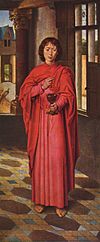 | |
| Apostle | |
| Born | c. 6 AD Bethsaida, Judaea, Roman Empire |
| Died | c. 100 (aged around 94) Ephesus, Asia, Roman Empire |
| Venerated in | Christianity |
| Canonized | Pre-congregation |
| Feast | 27 December (Roman Catholic) 26 September (Orthodox) |
| Attributes | Book, a serpent in a chalice, cauldron, eagle |
| Patronage | Love, loyalty, friendships, authors, booksellers, burn-victims, poison-victims, art-dealers, editors, papermakers, publishers, scribes, scholars, theologians |
John the Apostle (Template:Lang-arc Yohanan Shliha; c. AD 6 – c. 100) was one of the Twelve Apostles of Jesus according to the New Testament. He was the son of Zebedee and Salome. His brother was James, who was another of the Twelve Apostles. Christian tradition holds that he outlived the remaining apostles and that he was the only one not to die a martyr's death. The Church Fathers consider him the same person as John the Evangelist, John of Patmos, and the Beloved Disciple. The tradition of many Christian denominations holds that he is the author of several books of the New Testament.
New Testament author
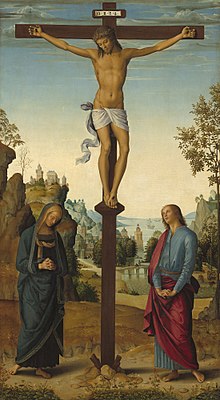

Church tradition holds that John is the author of the Gospel of John and four other books of the New Testament — the three Epistles of John and the Book of Revelation. In the Gospel, authorship is internally credited to the "disciple whom Jesus loved" (ὁ μαθητὴς ὃν ἠγάπα ὁ Ἰησοῦς, o pathētēs on ēgapa o Iēsous) in John 20:2. John 21:24 claims that the Gospel of John is based on the written testimony of the "Beloved Disciple". The authorship of some Johannine literature has been debated since about the year 200. Some doubt that the "Gospel of John" was written by an individual named "John" (Ἰωάννης or יוחנן). Nevertheless, the notion of "John the Evangelist" exists, and is usually thought of as the same as the Apostle John.
In "The History of The Church", Eusebius says that the books of first John, and the gospel of John are heavily agreed upon as his. However, Eusibius mentions that the consensus is that second and third are not his, but of some other John. Eusebius also goes to some length to establish with the reader that there is no general consensus regarding the Revelation of John. The revelation of John could only be what is now called the book of Revelation. The Gospel according to John differs considerably from the Synoptic Gospels, likely written decades earlier than John's Gospel. The bishops of Asia Minor supposedly requested him to write his gospel to deal with the heresy of the Ebionites, who asserted that Christ did not exist before Mary. John probably knew and undoubtedly approved of the Gospels of Matthew, Mark, and Luke, but these gospels spoke of Jesus primarily in the year following the imprisonment and death of John the Baptist. Around 600, however, Sophronius of Jerusalem noted that "two epistles bearing his name ... are considered by some to be the work of a certain John the Elder" and, while stating that Revelation was written by John of Patmos, it was "later translated by Justin Martyr and Irenaeus", presumably in an attempt to reconcile tradition with the obvious differences in Greek style.
Until the 19th century, the authorship of the Gospel of John had universally been attributed to the Apostle John. However, most modern critical scholars have their doubts. Some scholars agree in placing the Gospel of John somewhere between AD 65 and 85, John Robinson proposes an initial edition by 50–55 and then a final edition by 65 due to narrative similarities with Paul. Other scholars are of the opinion that the Gospel of John was composed in two or three stages. Some contemporary scholars are of the opinion that the Gospel was not written until the latter third of the first century AD. The Dean of New Testament at Wake Forest University School of Divinity, Gail R O'Day, writes in her introduction to the Gospel in the New Revised Standard Translation of the Bible "...a date of 75-80 CE as the earliest possible date of composition for this Gospel". Other scholars think that an even later date, perhaps even the last decade of the first century AD right up to the start of the 2nd century (i.e. 90 - 100), is applicable.
Today, many theological scholars continue to accept the traditional authorship. Colin G. Kruse states that since John the Evangelist has been named consistently in the writings of early church fathers, "it is hard to pass by this conclusion, despite widespread reluctance to accept it by many, but by no means all, modern scholars."
The Gospel of John was written by an anonymous author. According to Paul N. Anderson, the gospel "contains more direct claims to eyewitness origins than any of the other Gospel traditions". F. F. Bruce argues that 19:35 contains an "emphatic and explicit claim to eyewitness authority". Bart D. Ehrman, however, does not think the gospel claims to have been written by direct witnesses to the reported events.
However, the Gospel's chapter 21 ends (at verse 24) with an explicit declaration unifying the witness and authorship, in the form of a literary device of postponement of the discovery of the identity of the mysterious "other disciple," and "disciple he loved," and "this man," the first two used multiple times across the expanse of eye-witness accounts:
- "This is the disciple which testifieth of these things, and wrote these things: and we know that his testimony is true." (Source, AV)
Book of Revelation
The author of the Book of Revelation identifies himself as "John" The early 2nd century writer, Justin Martyr, was the first to equate the author of Revelation with John the Apostle. However, some biblical scholars now contend that these were separate individuals.
John the Presbyter, an obscure figure in the early church, has also been identified with the seer of the Book of Revelation by such authors as Eusebius and Jerome.
John is considered to have been exiled to Patmos, during the persecutions under Emperor Domitian. Revelation 1:9 says that the author wrote the book on Patmos: "I, John, both your brother and companion in tribulation... was on the island that is called Patmos for the word of God and for the testimony of Jesus Christ." Adela Yarbro Collins, a biblical scholar at Yale Divinity School, writes:
- "Early tradition says that John was banished to Patmos by the Roman authorities. This tradition is credible because banishment was a common punishment used during the Imperial period for a number of offenses. Among such offenses were the practices of magic and astrology. Prophecy was viewed by the Romans as belonging to the same category, whether Pagan, Jewish, or Christian. Prophecy with political implications, like that expressed by John in the book of Revelation, would have been perceived as a threat to Roman political power and order. Three of the islands in the Sporades were places where political offenders were banished." (Pliny Natural History 4.69-70; Tacitus Annals 4.30)
Some modern higher critical scholars have raised the possibility that John the Apostle, John the Evangelist, and John of Patmos were three separate individuals. These scholars assert that John of Patmos wrote Revelation but neither the Gospel of John nor the Epistles of John. For one, the author of Revelation identifies himself as "John" several times, but the author of the Gospel of John never identifies himself directly. Some Catholic scholars state that "vocabulary, grammar, and style make it doubtful that the book could have been put into its present form by the same person(s) responsible for the fourth gospel".
References to John in the New Testament

Sons of thunder
John the Apostle was the son of Zebedee and the younger brother of James, son of Zebedee (Saint James the Greater). According to Church tradition, their mother was Salome. Zebedee and his sons fished in the Sea of Galilee. The brothers were firstly disciples of John the Baptist. Jesus then called Saint Peter, Saint Andrew and these two sons of Zebedee to follow him. James and John are listed among the Twelve Apostles. Jesus referred to the pair as "Boanerges" (translated "sons of thunder"); although their nature was calm and gentle, when their patience was pushed to its limits their anger became wild and thunderous causing them to speak out like an untamed storm. A gospel story relates how the brothers wanted to call down heavenly fire on a Samaritan town, but Jesus rebuked them. Lk 9:51–6 John lived more than half a century after the martyrdom of James, who was the first Apostle to die a martyr's death.
Other references to John
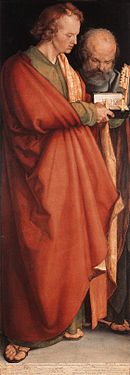
Peter, James and John were the only witnesses of the raising of Daughter of Jairus. All three also witnessed the Transfiguration, and these same three witnessed the Agony in Gethsemane more closely than the other Apostles did.
Jesus sent only John and Peter into the city to make the preparation for the final Passover meal (the Last Supper).Lk 22:8 At the meal itself, the "disciple whom Jesus loved" sat next to Jesus. It was customary to lie along upon couches at meals, and this disciple leaned on Jesus. Tradition identifies this disciple as Saint JohnJn 13:23–25. After the arrest of Jesus, Peter and the "other disciple" (according to Sacred Tradition), John followed him into the palace of the high-priest.
John alone among the Apostles remained near Jesus at the foot of the cross on Calvary alongside myrrhbearers and numerous other women; following the instruction of Jesus from the Cross, John took Mary, the mother of Jesus, into his care as the last legacy of Jesus Jn 19:25–27. After Jesus' Ascension and the descent of the Holy Spirit on Pentecost, John, together with Peter, took a prominent part in the founding and guidance of the church. He is with Peter at the healing of the lame man in the Temple.Ac 3:1 et seq.Template:Bibleverse with invalid book With Peter he is also thrown into prison.Acts 4:3 He is also with Peter visiting the newly converted in Samaria.Acts 8:14
While he remained in Judea and the surrounding area, the other disciples returned to Jerusalem for the Apostolic Council (about AD 51). Paul, in opposing his enemies in Galatia, recalls that John explicitly, along with Peter and James the Just, were referred to as "pillars of the church" and refers to the recognition that his Apostolic preaching of a gospel free from Jewish Law received from these three, the most prominent men of the messianic community at Jerusalem.
According to the Book of Revelation, its author was on the island of Patmos "for the word of God and for the testimony of Jesus", when he was honoured with the vision contained in Revelation.Rev. 1:9
The Disciple whom Jesus loved

The phrase the disciple whom Jesus loved (Template:Lang-el, ho mathētēs hon ēgapā ho Iēsous) or, in John 20:2, the Beloved Disciple (Template:Lang-el, hon ephilei ho Iēsous) is used five times in the Gospel of John, but in no other New Testament accounts of Jesus. John 21:24 claims that the Gospel of John is based on the written testimony of this disciple.
The disciple whom Jesus loved is referred to, specifically, six times in John's gospel:
- It is this disciple who, while reclining beside Jesus at the Last Supper, asks Jesus, after being requested by Peter to do so, who it is that will betray him.Jn 13:23–25
- Later at the crucifixion, Jesus tells his mother, "Woman, here is your son", and to the Beloved Disciple he says, "Here is your mother."Jn 19:26–27
- When Mary Magdalene discovers the empty tomb, she runs to tell the Beloved Disciple and Peter. The two men rush to the empty tomb and the Beloved Disciple is the first to reach the empty tomb. However, Peter is the first to enter.Jn 20:1–10
- In John 21, the last chapter of the Gospel of John, the Beloved Disciple is one of seven fishermen involved in the miraculous catch of 153 fish.Jn 21:1–25
- Also in the book's final chapter, after Jesus hints to Peter how Peter will die, Peter sees the Beloved Disciple following them and asks, "What about him?" Jesus answers, "If I want him to remain until I come, what is that to you? You follow Me!"John 21:20–23
- Again in the gospel's last chapter, it states that the very book itself is based on the written testimony of the disciple whom Jesus loved.John 21:24
None of the other Gospels has anyone in the parallel scenes that could be directly understood as the Beloved Disciple. For example, in Luke 24:12, Peter alone runs to the tomb. Mark, Matthew and Luke do not mention any one of the twelve disciples having witnessed the crucifixion.
There are also two references to an unnamed "other disciple" in John 1:35–40 and John 18:15–16, which may be to the same person based on the wording in John 20:2.
Extrabiblical traditions

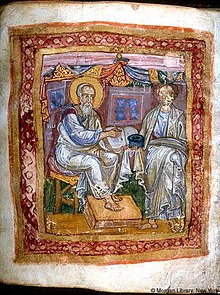
There is no information in the Bible concerning the duration of John's activity in Judea. According to tradition, John and the other Apostles remained some 12 years in this first field of labour. The persecution of Christians under Herod Agrippa I led to the scattering of the Apostles through the Roman Empire's provinces. cf. Ac 12:1–17Template:Bibleverse with invalid book.
A messianic community existed at Ephesus before Paul's first labours there (cf. "the brethren"),Acts 18:27 in addition to Priscilla and Aquila. The original community was under the leadership of Apollo (1 Corinthians 1:12). They were disciples of John the Baptist and were converted by Aquila and Priscilla. According to Church tradition, after the Assumption of Mary, John went to Ephesus. From there he wrote the three epistles attributed to him. John was allegedly banished by the Roman authorities to the Greek island of Patmos, where, according to tradition, he wrote the Book of Revelation. According to Tertullian (in The Prescription of Heretics) John was banished (presumably to Patmos) after being plunged into boiling oil in Rome and suffering nothing from it. It is said that all in the audience of Colosseum were converted to Christianity upon witnessing this miracle. This event would have occurred in the late 1st century, during the reign of the Emperor Domitian, who was known for his persecution of Christians.
When John was aged, he trained Polycarp who later became Bishop of Smyrna. This was important because Polycarp was able to carry John's message to future generations. Polycarp taught Irenaeus, passing on to him stories about John. In Against Heresies, Irenaeus relates how Polycarp told a story of
John, the disciple of the Lord, going to bathe at Ephesus, and perceiving Cerinthus within, rushed out of the bath-house without bathing, exclaiming, "Let us fly, lest even the bath-house fall down, because Cerinthus, the enemy of the truth, is within."
It is traditionally believed that John was the youngest of the apostles and survived them. He is said to have lived to an old age, dying at Ephesus sometime after AD 98.
An alternative account of John's death, ascribed by later Christian writers to the early second-century bishop Papias of Hierapolis, claims that he was slain by the Jews. Most Johannine scholars doubt the reliability of its ascription to Papias, but a minority, including B.W. Bacon, Martin Hengel and Henry Barclay Swete, maintain that these references to Papias are credible. Zahn argues that this reference is actually to John the Baptist. John's traditional tomb is thought to be located at Selçuk, a small town in the vicinity of Ephesus.
In art, John as the presumed author of the Gospel is often depicted with an eagle, which symbolizes the height he rose to in his gospel. In Orthodox icons, he is often depicted looking up into heaven and dictating his Gospel (or the Book of Revelation) to his disciple, traditionally named Prochorus.
Liturgical commemoration
The feast day of Saint John in the Roman Catholic Church, which calls him "Saint John, Apostle and Evangelist", and in the Anglican Communion and Lutheran Calendars, which call him "John, Apostle and Evangelist", is on 27 December. In the Tridentine Calendar he was commemorated also on each of the following days up to and including 3 January, the Octave of the 27 December feast. This Octave was abolished by Pope Pius XII in 1955. The traditional liturgical color is white.
Until 1960, another feast day which appeared in the General Roman Calendar is that of "Saint John Before the Latin Gate" on May 6, celebrating a tradition recounted by Jerome that St John was brought to Rome during the reign of the Emperor Domitian, and was thrown in a vat of boiling oil, from which he was miraculously preserved unharmed. A church (San Giovanni a Porta Latina) dedicated to him was built near the Latin gate of Rome, the traditional site of this event.
The Eastern Orthodox Church and those Eastern Catholic Churches which follow the Byzantine Rite commemorate the "Repose of the Holy Apostle and Evangelist John the Theologian" on September 26. On May 8 they celebrate the "Feast of the Holy Apostle and Evangelist John the Theologian", on which date Christians used to draw forth from his grave fine ashes which were believed to be effective for healing the sick.
Other Christians highly revere him but do not canonize or venerate saints.
Other Christian views
| Part of a series of articles on |
| John in the Bible |
|---|
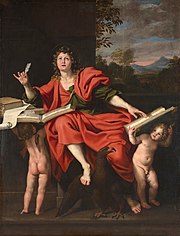 Saint John the Evangelist, Domenichino Saint John the Evangelist, Domenichino |
| Johannine literature |
| Authorship |
| Related literature |
| See also |
Latter-day Saint view
The Church of Jesus Christ of Latter-day Saints (LDS Church) teaches that John received the promise of immortality from Jesus Christ, as recorded in John 21:21–23 and the seventh chapter of the Doctrine and Covenants. It also teaches that in 1829, along with the resurrected Peter and the resurrected James, John visited Joseph Smith and Oliver Cowdery and restored the priesthood authority with Apostolic succession to earth. John, along with the Three Nephites, will live to see the Second Coming of Christ as translated beings.
The LDS Church teaches that John the Apostle is the same person as John the Evangelist, John of Patmos, and the Beloved Disciple.
Views of non-Christians
Islamic view
The Quran also speaks of Jesus's disciples but does not mention their names, instead referring to them as "helpers to the work of God". Muslim exegesis and Quran commentary, however, names them and includes John among the disciples. An old tradition, which involves the legend of Habib the Carpenter, mentions that John was one of the three disciples sent to Antioch to preach to the people there.
Gallery of art
- John the Apostle
-
 St John at Patmos by Pieter Paul Rubens
St John at Patmos by Pieter Paul Rubens
-
 John the Apostle and St Francis by El Greco
John the Apostle and St Francis by El Greco
-
 Martyrdom of Saint John the Evangelist by Master of the Winkler Epitaph
Martyrdom of Saint John the Evangelist by Master of the Winkler Epitaph
-
 John the Apostle from Saint-Thégonnec, France
John the Apostle from Saint-Thégonnec, France
-
 Valentin de Boulogne, John and Jesus
Valentin de Boulogne, John and Jesus
-
 St. John the Evangelist in meditation by Simone Cantarini (1612-1648), Bologna
St. John the Evangelist in meditation by Simone Cantarini (1612-1648), Bologna
-
 Saint John and the Poisoned Cup by El Greco
Saint John and the Poisoned Cup by El Greco
-
 John the Apostle resting on the bosom of Christ, Lake Constance region, c. 1310 Oakwood, original colouring.
John the Apostle resting on the bosom of Christ, Lake Constance region, c. 1310 Oakwood, original colouring.
-
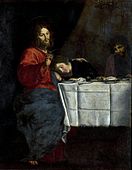 The Last Supper, anonymous painter
The Last Supper, anonymous painter
-
 A portrait from the Book of Kells, c. 800
A portrait from the Book of Kells, c. 800
See also
See also: Acts of John- Basilica of St. John
- Four evangelists
- Names of John
- St. John the Evangelist on Patmos
- Vision of St. John on Patmos, frescos by Antonio da Correggio
References
- ^ Saint Sophronius of Jerusalem (2007) , "The Life of the Evangelist John", The Explanation of the Holy Gospel According to John, House Springs, Missouri, USA: Chrysostom Press, pp. 2–3, ISBN 1-889814-09-1
- Eusebius of Caesarea, Ecclesiastical History Book vi. Chapter xxv.
- Van den Biesen, Christian. "Apocalypse." The Catholic Encyclopedia. Vol. 1. New York: Robert Appleton Company, 1907. 6 Feb. 2013
- The History of the Church by Eusibius. Book three, point 24.
- Thomas Patrick Halton, On illustrious men, Volume 100 of The Fathers of the Church, CUA Press, 1999. P. 19.
- ^ Harris, Stephen L., Understanding the Bible (Palo Alto: Mayfield, 1985) p. 355
- ^ Foley OFM, Leonard. "Saint of the Day: Lives, Lessons and Feast", (revised by Pat McCloskey, OFM), American Catholic.org
- Harris, Stephen L., Understanding the Bible. McGraw-Hill, 2006. ISBN 978-0-07-296548-3
- Robinson, John A.T. (1977). Redating the New Testament. SCM Press. ISBN 978-0-334-02300-5.
- Mark Allan Powell. Jesus as a figure in history. Westminster John Knox Press, 1998. ISBN 0-664-25703-8 / 978-0664257033
- .Abingdon Press, Nashville, 2003, p.1906
- Reading John, Francis J. Moloney, SDB, Dove Press, 1995
- Kruse, Colin G.The Gospel According to John: An Introduction and Commentary, Eerdmans, 2004, ISBN 0-8028-2771-3, p. 28.
- E P Sanders, The Historical Figure of Jesus, (Penguin, 1995) page 63 - 64.
- Bart D. Ehrman (2000:43) The New Testament: a historical introduction to early Christian writings. Oxford University Press.
- ^ Bart D. Ehrman (2005:235) Lost Christianities: the battles for scripture and the faiths we never knew Oxford University Press, New York.
- Geoffrey W. Bromiley (1995:287) International Standard Bible Encyclopedia: K-P MATTHEW, GOSPEL ACCORDING TO. Wm. B. Eerdmans Publishing. Quote: „Matthew, like the other three Gospels is an anonymous document.”
- Donald Senior, Paul J. Achtemeier, Robert J. Karris (2002:328) Invitation to the Gospels Paulist Press.
- Keith Fullerton Nickle (2001:43) The Synoptic Gospels: an introduction Westminster John Knox Press.
- Ben Witherington (2004:44) The Gospel code: novel claims about Jesus, Mary Magdalene, and Da Vinci InterVarsity Press.
- F.F. Bruce (1994:1) The Gospel of John Wm. B. Eerdmans Publishing.
- Patrick J. Flannagan (1997:16) The Gospel of Mark Made Easy Paulist Press
- Paul N. Anderson, The Riddles of the Fourth Gospel, p. 48.
- F. F. Bruce, The Gospel of John, p. 3.
- Bart D. Ehrman (2004:110) Truth and Fiction in The Da Vinci Code: A Historian Reveals What We Really Know about Jesus, Mary Magdalene, and Constantine. Oxford University Press.
- Bart D. Ehrman(2006:143) The lost Gospel of Judas Iscariot: a new look at betrayer and betrayed. Oxford University Press.
- "Revelation, Book of." Cross, F. L., ed. The Oxford dictionary of the Christian church. New York: Oxford University Press. 2005
- Justin Martyr, Dialogue with Trypho, 81.4
- Ehrman, Bart D. (2004). The New Testament: A Historical Introduction to the Early Christian Writings. New York: Oxford. p. 468. ISBN 0-19-515462-2.
- Adela Collins. "Patmos." Harper's Bible Dictionary. Paul J. Achtemeier, gen. ed. San Francisco: Harper & Row, 1985. p755.
- Griggs, C. Wilfred. "John the Beloved" in Ludlow, Daniel H., ed. Selections from the Encyclopedia of Mormonism: Scriptures of the Church (Salt Lake City, Utah: Deseret Book, 1992) p. 379. Griggs favors the "one John" theory but mentions that some modern scholars have hypothesized that there are multiple Johns.
- Introduction. Saint Joseph Edition of the New American Bible: Translated from the Original Languages with Critical Use of All the Ancient Sources : including the Revised New Testament and the Revised Psalms. New York: Catholic Book Pub., 1992. 386. Print.
- By comparing 27:56 Matthew 27:56 to 15:40 Mark 15:40
- ^ "Fonck, Leopold. "St. John the Evangelist." The Catholic Encyclopedia. Vol. 8. New York: Robert Appleton Company, 1910. 6 Feb. 2013". Newadvent.org. 1910-10-01. Retrieved 2013-05-03.
- ^ Butler, Alban. The Lives or the Fathers, Martyrs and Other Principal Saints, Vol.IV
- While Luke states that this is the Passover,Lk 22:7–9 the Gospel of John specifically states that the Passover meal is to be partaken of on FridayJn 18:28
- John 13:23, 19:26, 20:2, 21:7, 21:20
- James D. G. Dunn and John William Rogerson, Eerdmans Commentary on the Bible, Wm. B. Eerdmans Publishing, 2003, p. 1210, ISBN 0-8028-3711-5.
- Brown, Raymond E. 1970. "The Gospel According to John (xiii-xxi)". New York: Doubleday & Co. Pages 922, 955.
- "Vailhé, Siméon. "Ephesus." The Catholic Encyclopedia. Vol. 5. New York: Robert Appleton Company, 1909. 6 Feb. 2013". Newadvent.org. 1909-05-01. Retrieved 2013-05-03.
- Irenaeus, Against Heresies, III.3.4.
- ^ Zahn, T. "John the Apostle", in Schaff, Philip. The New Schaff-Herzog Encyclopedia of Religious Knowledge, Vol. VI: Innocents - Liudger, p.203
- Cheyne, Thomas Kelly (1901). Encyclopaedia Biblica, Volume 2. Adam and Charles Black. pp. 2509–11. Although Papias' works are no longer extant, the fifth century ecclesiastical historian Philip of Side and the ninth-century monk George Hamartolos both stated that Papias had written that John was "slain by the Jews."
- Rasimus, Tuomas (2010). The Legacy of John: Second-Century Reception of the Fourth Gospel. BRILL. p. 5. ISBN 9789004176331. Rasimus finds corroborating evidence for this tradition in "two martyrologies from Edessa and Carthage" and writes that "Mark 10:35-40//Matt. 20:20-23 can be taken to portray Jesus predicting the martyrdom of both the sons of Zebedee."
- Culpepper, R. Alan (2000). John, the Son of Zebedee: The Life of A Legend. Continuum International Publishing Group. p. 172. ISBN 9780567087423.
- Swete, Henry Barclay (1911). The Apocalypse of St. John (3 ed.). Macmillan. pp. 179–180.
- General Roman Calendar of Pope Pius XII
- Saint Andrew Daily Missal with Vespers for Sundays and Feasts by Dom. Gaspar LeFebvre, O.S.B., Saint Paul, MN: The E.M. Lohmann Co., 1952, p.1325-1326
- Doctrine and Covenants 27:12.
- ^ "John", Bible Dictionary (LDS Church).
- Qur'an 3:49-53
- Historical Dictionary of Prophets In Islam And Judaism, Brandon M. Wheeler, Disciples of Christ: "Muslim exegesis identifies the disciples as Peter, Andrew, Matthew, Thomas, Philip, John, James, Bartholomew, and Simon"
- Hughes Dictionary of Islam, Habib the Carpenter
External links
- The Life and Miracles of St. John the Evangelist and Apostle
- Eastern Orthodox icon and Synaxarion of Saint John the Apostle and Evangelist (May 8)
- John the Apostle on Find-A-Grave
- John the Apostle in Art
- John in Art
- Repose of the Holy Apostle and Evangelist John the Theologian Orthodox icon and synaxarion for September 26
| Twelve Apostles of Jesus | |
|---|---|
| Apostles | |
| Later | |
| Related | |
| History of Christianity | |||||||||
|---|---|---|---|---|---|---|---|---|---|
| Centuries | |||||||||
| Origins and Apostolic Age | |||||||||
| Ante-Nicene period | |||||||||
| Late antiquity (Great Church) | |||||||||
| Catholicism | |||||||||
| Eastern Christianity | |||||||||
| Middle Ages |
| ||||||||
| Reformation and Protestantism |
| ||||||||
| 1640–1789 | |||||||||
| 1789–present |
| ||||||||
| Saints of the Catholic Church | |
|---|---|
| Dicastery for the Causes of Saints Stages of canonization: Servant of God → Venerable → Blessed → Saint | |
| Virgin Mary | |
| Apostles | |
| Archangels | |
| Confessors |
|
| Disciples | |
| Doctors of the Church |
|
| Evangelists | |
| Church Fathers |
|
| Martyrs |
|
| Missionaries | |
| Patriarchs | |
| Popes |
|
| Prophets | |
| Virgins |
|
| See also | |
- 6 births
- 100 deaths
- John the Apostle
- 1st-century Christian saints
- 1st-century theologians
- Angelic visionaries
- Anglican saints
- Book of Revelation
- Burials in Turkey
- Christian mystics
- Eastern Orthodox saints
- Letter writers
- People celebrated in the Lutheran liturgical calendar
- Roman-era Jews
- Saints from the Holy Land
- Saints of the Golden Legend